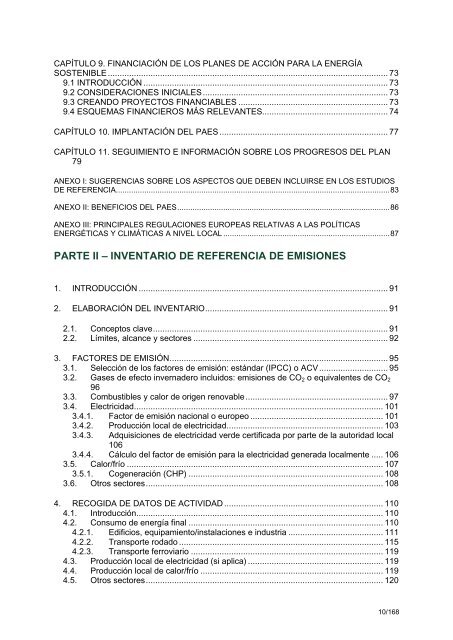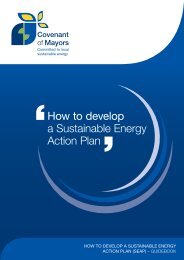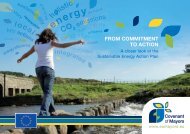cómo desarrollar un plan de acción para la energía sostenible (paes)
cómo desarrollar un plan de acción para la energía sostenible (paes)
cómo desarrollar un plan de acción para la energía sostenible (paes)
You also want an ePaper? Increase the reach of your titles
YUMPU automatically turns print PDFs into web optimized ePapers that Google loves.
CAPÍTULO 9. FINANCIACIÓN DE LOS PLANES DE ACCIÓN PARA LA ENERGÍA<br />
SOSTENIBLE...................................................................................................................... 73<br />
9.1 INTRODUCCIÓN ....................................................................................................... 73<br />
9.2 CONSIDERACIONES INICIALES.............................................................................. 73<br />
9.3 CREANDO PROYECTOS FINANCIABLES ............................................................... 73<br />
9.4 ESQUEMAS FINANCIEROS MÁS RELEVANTES..................................................... 74<br />
CAPÍTULO 10. IMPLANTACIÓN DEL PAES....................................................................... 77<br />
CAPÍTULO 11. SEGUIMIENTO E INFORMACIÓN SOBRE LOS PROGRESOS DEL PLAN<br />
79<br />
ANEXO I: SUGERENCIAS SOBRE LOS ASPECTOS QUE DEBEN INCLUIRSE EN LOS ESTUDIOS<br />
DE REFERENCIA.............................................................................................................................83<br />
ANEXO II: BENEFICIOS DEL PAES.................................................................................................86<br />
ANEXO III: PRINCIPALES REGULACIONES EUROPEAS RELATIVAS A LAS POLÍTICAS<br />
ENERGÉTICAS Y CLIMÁTICAS A NIVEL LOCAL ............................................................................87<br />
PARTE II – INVENTARIO DE REFERENCIA DE EMISIONES<br />
1. INTRODUCCIÓN ......................................................................................................... 91<br />
2. ELABORACIÓN DEL INVENTARIO............................................................................. 91<br />
2.1. Conceptos c<strong>la</strong>ve................................................................................................... 91<br />
2.2. Límites, alcance y sectores .................................................................................. 92<br />
3. FACTORES DE EMISIÓN............................................................................................ 95<br />
3.1. Selección <strong>de</strong> los factores <strong>de</strong> emisión: estándar (IPCC) o ACV............................. 95<br />
3.2. Gases <strong>de</strong> efecto inverna<strong>de</strong>ro incluidos: emisiones <strong>de</strong> CO2 o equivalentes <strong>de</strong> CO2<br />
96<br />
3.3. Combustibles y calor <strong>de</strong> origen renovable............................................................ 97<br />
3.4. Electricidad......................................................................................................... 101<br />
3.4.1. Factor <strong>de</strong> emisión nacional o europeo ........................................................ 101<br />
3.4.2. Producción local <strong>de</strong> electricidad.................................................................. 103<br />
3.4.3. Adquisiciones <strong>de</strong> electricidad ver<strong>de</strong> certificada por parte <strong>de</strong> <strong>la</strong> autoridad local<br />
106<br />
3.4.4. Cálculo <strong>de</strong>l factor <strong>de</strong> emisión <strong>para</strong> <strong>la</strong> electricidad generada localmente ..... 106<br />
3.5. Calor/frío ............................................................................................................ 107<br />
3.5.1. Cogeneración (CHP) .................................................................................. 108<br />
3.6. Otros sectores.................................................................................................... 108<br />
4. RECOGIDA DE DATOS DE ACTIVIDAD ................................................................... 110<br />
4.1. Introducción........................................................................................................ 110<br />
4.2. Consumo <strong>de</strong> <strong>energía</strong> final .................................................................................. 110<br />
4.2.1. Edificios, equipamiento/insta<strong>la</strong>ciones e industria ........................................ 111<br />
4.2.2. Transporte rodado ...................................................................................... 115<br />
4.2.3. Transporte ferroviario ................................................................................. 119<br />
4.3. Producción local <strong>de</strong> electricidad (si aplica) ......................................................... 119<br />
4.4. Producción local <strong>de</strong> calor/frío ............................................................................. 119<br />
4.5. Otros sectores.................................................................................................... 120<br />
10/168





